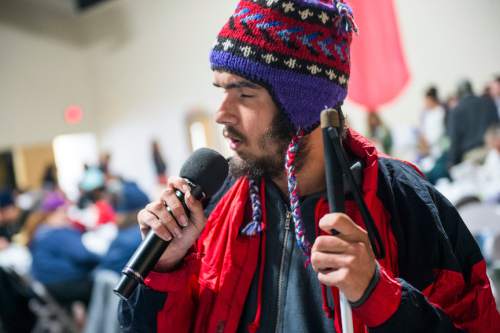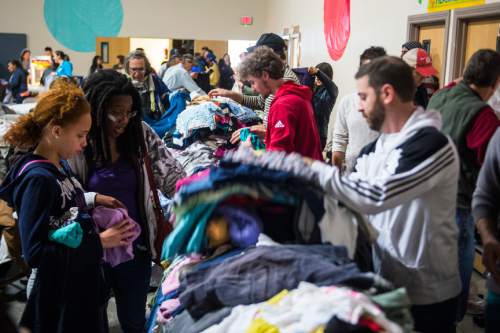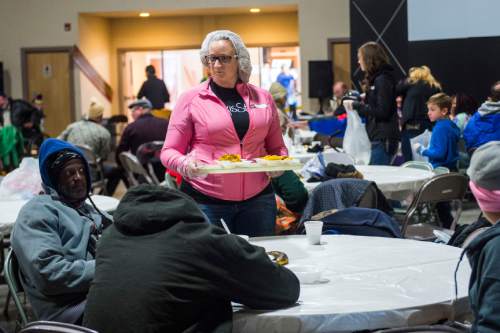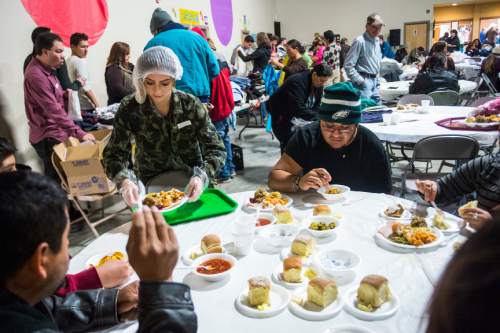This is an archived article that was published on sltrib.com in 2015, and information in the article may be outdated. It is provided only for personal research purposes and may not be reprinted.
There was much to be thankful for on Thursday at the Christian Life Center in Salt Lake Cty. The ready supply of coffee and warm food, especially the pumpkin pie and the nachos, were well-praised.
But more important, patrons said, was the sense of community fostered by having a regular place to gather for the holiday — even if they are homeless.
Salt Lake City Mission has hosted a banquet for the homeless — or anyone else who might need it — for 22 years, pastor Joe Vazquez said. The Salt Lake City community is naturally generous, he said, so the goal of the banquet was to act as a catalyst for bringing the community together in service. With the help of volunteers, the mission provides 3,500 meals as well as snacks, live entertainment and a warm holiday atmosphere for those in need.
This Thursday was a bit slower than past years, Vazquez said — the banquet tends to bring in more homeless people during years when the weather is colder. But Vazquez said he noticed the same trend among this year's patrons that he's seen over the past several years.
"We're finding more and more people coming with children," he said. "Every year, it just keeps increasing — we're helping more working poor."
Not all the children at Thursday's banquet were there to receive the food and clothes. The other trend Vazquez said he's seen grow recently is the number of families who bring their children to volunteer.
"It's a reality check," said Mike McNall, one of the banquet's volunteers. It was his first year at the Christian Life Center, he said — he and his wife, Sue, recently relocated from Florida to Draper. Feeding the homeless on Thanksgiving is a tradition for the McNalls; he said they started taking their children years ago, when it seemed to him that the holidays had become too materialistic.
McHall said he still remembers the second time his family volunteered on Thanksgiving, when one of the homeless women in the room stood up and spontaneously began to sing. The entire room fell still, he said.
"It was just phenomenal. She could have been a professional," he said. "I don't know why she wasn't … but it was beautiful."
From then on, McNall said, his family has been hooked on serving the homeless, because he said service encourages people to rethink their images of who ends up homeless.
Among Thursday's patrons were a writer, a carpenter and a former home-health aide.
"I left the job I was at for 30 years because I needed a change," said Eric Cheatwood, the former home-health aide. "I've done retail, management. Right now, I'm kind of in limbo."
Cheatwood said he became homeless — or, as he likes to call it, "residency impaired" — about a year ago, when his plans to move to Salt Lake City and look for change fell through and his savings ran out. His friend Jamar Everett tells a similar story. He moved to Salt Lake City to train to become a truck driver, and when that fell through, he found himself stuck in Salt Lake City with no way to get home.
Joining Cheatwood and Everett was Qhvian Anan-laul, the carpenter. Anan-laul said he'd taken a bus from Denver to Salt Lake City in an effort to start a new life after a divorce and the loss of his carpentry business. He said Cheatwood and Everett had taken him in to "show me the ropes of how to survive" on the streets of Salt Lake City.
Anan-laul said he was studying physics and psychology online while looking for a job and keeping his eye on the "big goal — getting out of here."
The trio's newest friend, Ryan Thompson, was encouraged by his recent progress toward that goal — he'd just got a job at a fast-food restaurant. Thompson was reluctant to tell his story because, he said, he was "that guy" everyone thinks of when they think of a homeless man: the guy who'd turned to drugs and petty crime. After graduating from high school, he said, he moved to Salt Lake City to attend a private university, but he dropped out when he felt he was being cheated by the school. He spent the next while "bumming around with friends" and started abusing drugs. Eventually, he said, he ended up homeless.
But now, Thompson said, he is clean and sober, employed, and saving up to marry his girlfriend and someday open a restaurant.
"I'm not that same person anymore," Thompson said, "but that's all anyone wants to see me as. When people find out you're at the shelter, they don't want to hire you."
That's not the only barrier that prevents homeless people from getting back on their feet. Thompson said Salt Lake City's services for the homeless were "a good start," but not without problems. For example, he said, the shelters' strict hours make it difficult to hold a job and find a bed to sleep in at night.
"By the time I get off work, I have to pray that there is still a bed left," he said. Otherwise, he said, he ends up out in the cold or sleeping on the floor.
Like many of the Christian Life Center's patrons, Thompson said he was worried about the rumored plan to split up the shelters and disperse them around Salt Lake City. If that happened, he said, it could sabotage his progress.
That's the talk among Salt Lake City's homeless population these days, said Rebecca Henshaw, a writer from Canada who says she had been homeless for three years. She said the movement to separate and disperse homeless shelters was a real concern among the people living in those shelters. Henshaw said one homeless woman she knows turned down an offer of permanent housing because she did not want to be separated from her daughter and granddaughter.
"There is kind of a set pattern of life here, and [the movement to disperse the home population] is upsetting.
"What they don't understand is that we are a very fragile minority in this community."
@EmaPen















